Disaster Site Management

Management of activities before, during and after an emergency is a difficult task. Different components must be considered to account for all the potential hazards that can be faced. The preparation of a comprehensive disaster management plan is vital to ensure the correct management of resources, consecution of activities and the protection of emergency response and recovery workers. During the elaboration of a disaster management plan, potential hazards can be identified which helps to establish the necessary measures to prevent, control, and mitigate those hazards. Such measures can include but are not limited to the establishment of a system to manage personnel during an emergency, provide training to face a particular hazard, define the use of personal protective equipment, and install guidelines and mechanisms to be used in case of an emergency, among others.
This topic page includes general information on Disaster Site Management. The site provides a series of reports on emergency responders’ safety management in disaster and terrorism response. The different reports cover topics such as rubble and debris, dust and smoke, heat, anthrax, stress, types and use of protective equipment, hazard assessment, risk communications, site management, structural collapse, fire, and explosions. The disaster management page also offers information on other hazards that may be involved in a disaster management task, such as asbestos, carbon monoxide, electrocution, confined spaces, falls, heat stress, chemical and structural hazards, and provides guidance on identifying and handling human remains. Other possible hazardous substances and situations such as chemical and structural hazards are also included in the website to ensure the health and safety of workers.

Asbestos is the name used to group a class of naturally occurring mineral fibers that have been widely used in the industry and is associated with adverse effects on human health. Asbestos fibers have been widely used in industrial and commercial applications because of its strength, flexibility and electrical and heat resistant properties. Some examples of its applications include automobile brakes, insulation materials, vermiculite, cement, and talc. When the mineral fibers are handled, they can be released into the air and be inhaled, because of their microscopic size and fibrous nature, which can lead to asbestos accumulating in the lungs and causing respiratory illness. Exposure to asbestos has been associated with adverse health effects such as lung cancer, asbestosis and mesothelioma.
Asbestos is well recognized as a health hazard and is highly regulated. An estimated 1.3 million employees in the construction and general industry face significant asbestos exposure on the job. Heaviest exposures occur in the construction industry, particularly during the removal of asbestos during renovation or demolition. Employees are also likely to be exposed during the manufacture of asbestos products (such as textiles, friction products, insulation, and other building materials) and during automotive brake and clutch repair work. In such cases that workers must have contact with asbestos, the use of personal protective equipment is necessary to prevent any potential exposure to the material.
The following links redirect to the NIOSH and OSHA asbestos topic pages. Materials provided include general guidance and recommendations regarding asbestos exposure prevention, reports, publications, guidelines, specific industry publications, applicable industry standards, sampling and analysis techniques, research studies findings, and surveillance reports.
NIOSH Asbestos Topic Page
NIOSH Asbestos topic page provides information focused on the prevention of asbestos exposures. NIOSH provides general and industry specific guidelines, publications, reports, programs and other asbestos resources. Examples of these documents include publications regarding malignant mesothelioma mortality, recommendations for limiting potential exposures of workers to asbestos associated with vermiculite, occupational health guidelines for asbestos, control of asbestos exposure during brake drum service, and criteria for a recommended standard occupational exposure to asbestos. Other documents include manuals with methods of sampling and analyze asbestos. Glove bag containment is also explained in this page to prevent asbestos emissions, other surveillance programs and documents associates to occupational respiratory disease surveillance and documentation are also available.
NIOSH Asbestos Topic Page
OSHA Asbestos Topic Page
The presence of asbestos in the workplace is a recognized health hazard that is strictly regulated. In the following page OSHA addresses their industry specific standards and provides information for different activities, highlighting potential hazards and how to control exposures. The exposure to asbestos must be reduced to the minimum allowable levels since the substance is recognized as a potential human carcinogen.
OSHA Asbestos Topic Page
Carbon monoxide (CO) is a gas produced as the result of incomplete combustion processes and is characterized by being odorless and colorless. Carbon Monoxide has the ability to combine to hemoglobin forming carboxyhemoglobin. This process inhibits the ability of hemoglobin to transport oxygen, leading to an oxygen deficiency that may result in permanent heart and brain damage or even death. CO properties make it especially difficult to detect, which increases the risk of injury or death by the inhalation of the gas.
During an emergency, usually electrical power deficiencies increase the use of gas powered generators generating CO and some workers may place generators in enclosed spaces which can lead to the accumulation of the gas resulting in CO poisoning.

Small gasoline-powered tools can pose a serious health hazard following natural disasters. Examples of these tools include pumps, compressors, and generators. They produce high concentrations of CO–a poisonous gas that can cause illness, permanent neurological damage, and death. This web page provides recommendations for employers, equipment users, tool rental agencies, and tool manufacturers for preventing CO poisoning. NIOSH makes available publications on how to prevent carbon monoxide poisoning from small gasoline powered engines, tools, and reports on fatality assessment and control evaluations.
NIOSH Safety and Health Topic: Carbon Monoxide Hazards from Small Gasoline Powered Engines
The CDC carbon monoxide topic page contains reports detailing the problems associated with carbon monoxide from portable generators, motorboats, fires, and other emission sources. Workers can find educational materials, prevention toolkits, factsheets and general safety recommendations to protect themselves. Other materials available include recent publications modelling the effects of the use of gasoline powered generators on indoor CO exposures, clinical guidance for CO poisoning, and disaster surveillance information and resources.
CDC Carbon Monoxide Poisoning Topic Page
Chemical substances that have the ability to create a physical or health hazard are considered hazardous.
Chemical agent information is needed for emergency response and recovery workers to appropriately plan for risks resulting from possible chemical incidents. Several organizations have developed information databases, including short-term and long-term criteria, each with specific purposes, exposure scenarios, and severity of adverse health effects considered in their development.
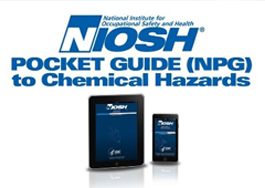
The NIOSH chemical hazards webpage has available resources that offer detailed information about particular chemical agents. An example of this is the chemical hazards emergency medical management website, where there is information for first responders for how to prepare to respond, how to conduct themselves arriving in the scene, and how to conduct casualty triage, assessment, treatment and transport, and train and plan. Some substances included are ammonia, chlorine, hydrogen cyanide, mustard agents, nerve agents, phosgene and other hazardous chemicals. Other resources that offer similar information including PPE recommendations are the Emergency Response Safety and Health database and the NIOSH pocket Guide to Chemical Hazards. The last resource, has a printer version available and also provides an app that allows users to look for the chemical structures, exposure limits, chemical and physical properties, emergency treatment, respirators selection, and signs and symptoms of exposures.
NIOSH Emergency Response Chemical Hazards Page
Spaces which by design have limited openings for entry and exit, unfavorable natural ventilation which could contain or produce dangerous air contaminants, and which are not intended for continuous employee occupancy are considered confined spaces and working in these environments requires special precautions.
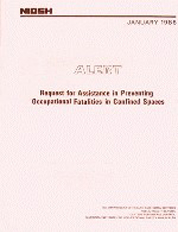
Emergency response and recovery workers may have to work in confined spaces such as pits, sewers, tunnels, pipelines, degreasers, ventilation and exhaust ducts among others. Air does not flow in a normal way in these spaces and gases and other substances may stay trapped increasing the possibility of explosion. In other cases, oxygen can be depleted and limit the respiratory capacity. When the work is necessary in these spaces the exposure time must be limited and must be conducted with the appropriate precautions, including the use of personal protective equipment.
The NIOSH confined spaces topic page provides publications describing cases in which the incidents lead to the death of workers are presented. A manual with information on the recognition of confined spaces, describing the types of hazards associated with working in confined spaces, recommendations on PPE and safe work practice advice is offered. Other materials such as a report of the fatality assessment and control evaluation (FACE) program which recognizes hazards in the workplace and provides recommendations for addressing them, and a publication that provides information on hazard prevention and control measures and strategies applied to confined spaces.
NIOSH Confined Spaces Topic Page
The following link provides interim guidance for working safely in confined spaces. This document was originally developed for Hurricane Katrina, where flooding and the consequent transportation of materials through the water may lead to its release in confined spaces, or where the restriction of evacuation routes can create confined spaces. This information is applicable for emergency response and recovery workers whose job requires entry in confined spaces. This document provides NIOSH interim guidelines regarding work in confined spaces in response to a hurricane and offers PPE recommendations.
NIOSH Interim Guidance: Working Safely in Confined Spaces
The OSHA confined spaces topic page explains what would be considered a confined space, defines the applicable standards for working in confined spaces for different industries, describes the potential hazards of working in confined spaces, and provides recommendations and potential solutions to these risks.
OSHA Confined Spaces Topic Page
Electrical work poses a hazard for emergency response and recovery workers where burns, falls, and electric shocks can cause injury or death if proper measures are not in place. During emergencies electrical services and equipment might present malfunctions and in some other cases the service might be out. During the installation service hazardous energy might be a source of injury or death. Elements such as overhead lines, circuits, and cables present a hazard for electric shocks and electrocution. Other electricity conducting elements such as ladders and other metal objects present an electrocution hazard. Safe work environments isolating energized components and safety procedures are a main part of safe work.

NIOSH provides different resources on electrical safety and electrocution. These resources include publications and fatality investigations. The electrical safety student manual provides general information on electrical hazards, explaining different types of hazards and types of electricity burns. The manual also provides an overview of a safety model, and how to recognize, evaluate and control electric hazards. Other NIOSH publications evaluate accidental contact with power lines as a cause of electrocution and document their operations to take preventive measures and avoid accidental injury or death. NIOSH publications also provide case studies and investigations that provide examples on how to install safety control measures. NIOSH Fatality Investigation reports and additional resources are also available for consultation.
NIOSH Traumatic Injury Topic Pages: Electrical Safety
This NIOSH publication includes recommendations that can be used to help save the lives of workers who have contact with electrical energy. Previous incidents have shown that immediate resuscitation could help save the lives of electrocution victims. This document provides access to previous case reports and provides recommendations to prevent electrocution, install safe practices, and advises on the use of cardiopulmonary resuscitation and advance cardiac life support.
Preventing Fatalities of Workers Who Contact Electrical Energy
The OSHA electrical topic page provides access to the industry specific applicable OSHA standards. Construction specific information is available to protect employees from electrical hazards. Hazard recognition in working environments is supported by explaining the hazards of contact with power lines, misused equipment, lack of the use of protective equipment and improper use of cords and elements conductive electricity. OSHA provides possible solutions to address these hazards and diminishes the risk of injury or death by electrical hazards. OSHA offers additional training to anticipate hazards and avoid injury.
OSHA Electrical Topic Page
During and after emergencies work activities may include the use of ladders, walking on unstable surfaces, climbing to above the ground heights, wading through surfaces with holes, among others. Emergency and recovery workers may be in potential risks to fall from ladders and roofs or suffer related accidents. This hazard is common and may lead to injury or even death. Identifying fall hazards, planning, and creating applicable strategies to reduce and eliminate fall hazards should be part of the measures applied before doing the work.
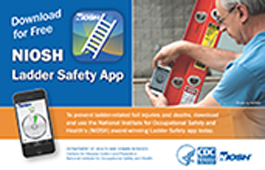
The following page provides fast facts to inform workers about the most common types of fall hazards at the workplace and the impact they have in different workplaces. The website provides some examples of controls that can be applied to prevent work related falls. NIOSH features the use of an app designed to use ladders safely. The app provides indications according to the position of the ladder, infographics, and additional information are also available for employers and emergency response and recovery workers.
NIOSH Traumatic Injury Topic Pages: Falls
In OSHA’S fall protection topic page OSHA provides information explaining the importance of preparing workplaces to prevent falls especially from platforms, elevated stations or walls. Advice and recommendations are offered to employers to protect their workers. Specific industry standards and resources for fall protection and references for recognizing and evaluating hazards in the workplace is available.
OSHA Fall Protection Topic Page
During and after emergencies health care workers may face multiple hazards as a result of a higher influx of patients and alterations in the everyday work conditions. These unusual conditions can include electricity, cuts, flooding, contamination of the water supply, lack of staff, and lack of supplies or equipment, among others. Hazards health care workers could face while working in an emergency may include exposure to infectious agents, needle stick injuries, chemical hazards, physical hazards, traumatic incident stress, violence, and long hours of work. Emergency responders and workers involved in health care need to be aware about the hazards they face and need to receive the necessary training to know how to act and stay safe during emergencies.

NIOSH provides resources to prevent hazards healthcare workers might be exposed to during emergencies. Some of these resources include publications, field notes, infographics, factsheets, training tools, and reports. Some examples of emergencies in which health care workers require special safety measures, such as Ebola, are provided in the website aiming to protect the health of workers. Other resources such as health and safety practices for healthcare workers are also provided.
NIOSH Health Care Workers Topic Page
During emergencies exposure to blood and other body fluids are common. Health care workers are at special risks of exposure to blood borne infectious diseases. Concerns include the transmission of human immunodeficiency virus (HIV) and hepatitis. This webpage offers recommendations to establish work practices that prevent exposure to body fluids. Other resources offered include information on bloodborne pathogens, recommendations to prevent needle-sticks and sharps injuries, engineering controls, Personal protective equipment, and management and treatment guidelines.
NIOSH Bloodborne Infectious Diseases HIV/AIDS, Hepatitis B Virus, and Hepatitis C Virus Topic Page
Extreme heat poses a risk for emergency response and recovery workers who may have to endure long hours outdoors. After a long time with heat exposure and without proper control, the body loses its capacity to balance its temperature which could lead to the apparition of adverse health effects. Occupational exposure to heat stress has been associated with heat stroke, exhaustion, rashes, cramps and dehydration. Symptoms to identify heat stress may include confusion, seizures, headaches, nausea, and loss of coordination. There are some protective measures workers can take to prevent heat stress including hydration and control of heat exposure.
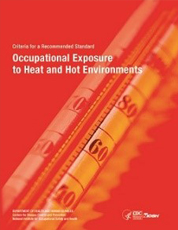
In the following link, NIOSH provides different types of materials to inform workers and employers to illnesses and consequences associated with extreme heat. Some of these materials include infographics, publications describing previous cases of heat related death and injury in agricultural workers, recommendations for the construction industry on hydrations and recommendations applicable to all workers to protect themselves from heat illness. NIOSH has other tools such as an app to prevent workers from exposure to extreme heat and a heat stress podcast so workers can learn to identify symptoms and how to prevent and control them.
NIOSH Heat Stress Topic Page
Depending on the magnitude of an emergency, some events might be more destructive than others and have associated more fatalities. It is important to provide the proper identification and care for the bodies, and to protect the health and safety of the emergency responders and recovery workers on the location. Hazards when working with human remains may include a risks of infection with bloodborne pathogens and diarrheal diseases. Therefore the use of controls, protocols and standard protection measures is vital to ensure a dignified treatment of the victims while protecting the health and safety of the workers.
Health Concerns Associated with Disaster Victim Identification after a Tsunami
This report describes the health concerns associated with the identification of human victims after a tsunami in the Indian Ocean. Identification and proper handling of victims can be a challenge after a massive event. This report describes a previous experience using temporary morgue operations after the 2004 Tsunami. It describes the hazards of accidental injury with sharps and needles and manipulation of solid waste and biohazardous waste. The report provides recommendations for the proper management of waste and the use of personal protective equipment such as surgical masks, respirators, and latex gloves to protect themselves from multiple hazards.
Health Concerns Associated with Disaster Victim Identification after a Tsunami
Interim Health Recommendations for Workers who Handle Human Remains
The following website provides recommendations for individuals who must have direct contact with human remains. Recommendations include proper hygiene practices and the use of personal protective equipment to prevent contact with body fluids, blood or fecal material resulting of handling human bodies. Additionally to the interim guidance, some additional resources from the pan American health organization and the word health organizations are also mentioned.
Interim Health Recommendations for Workers who Handle Human Remains
Emergency management in specific industries such as mining present different challenges due to the nature of the activities and locations where mining is performed. Generally mine workers are properly trained to respond to an emergency. Training is vital in an activity such as mining and workers must be aware of alternative exit routes and the types of decisions, tools, and protective equipment that are appropriate in case of an emergency. Hazards in mines include falls, asphyxia, poisoning, explosions, inundations, traps, fatigue, injuries, electrocution, and fire, among others. In addition, health and safety practices such as engineering controls, use of personal protective equipment, control of exposures, and scheduled shifts for work are required to reduce hazards. One example of these measures is the use of refuge chambers, where workers can seek refuge in case of an emergency.
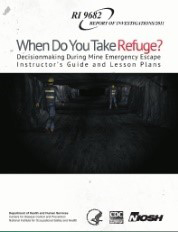
The following link provides information regarding tragic events that have happened over a decade. It includes information on implementing realistic training simulations and improving the technology used for rescue, exploration, recovery, firefighting, and evacuation operations in mines. Recommendations include different types of engineering controls and personal protective equipment.
NIOSH Mining Safety and Health Topic – Emergency management
Musculoskeletal hazards are common across all work settings. Depending on the type of activity, different ergonomic controls must be in place to prevent injury. Activities that involve the use of heavy elements, vibration, repeat movements, and stay in a particular position and sustain an awkward posture can lead to musculoskeletal adverse effects. Emergency response and recovery workers are in risk of exposure to musculoskeletal hazards after working during long hours in extreme conditions that can imply difficult and repetitive motions. Musculoskeletal hazards may lead to the development of chronic pain in extremities, muscles, illness, injury, disorders and pain. This hazard may be present across multiple activities and industries including agriculture, construction, healthcare, manufacturing, mining, and transportation among others.

NIOSH offers a bibliographic database of occupational safety and health publications, interventions across industrial sectors, ergonomic recommendations, studies, and other resources to workers and employers to reduce and prevent ergonomics hazards. An example of these resources is the NIOSHTIC-2 website, which offers more than a thousand bibliographic entries covering specifically musculoskeletal or ergonomic hazards in different occupations and industries. Materials offering solutions and controls to prevent ergonomic and musculoskeletal hazards in the workplace, according to the activity performed, are offered by NIOSH. The website includes different recommendations covering the use of ergonomic programs in the workplace with a respective evaluation of the potential hazards of each activity, some manuals, apps and guidelines and recommendations regarding posture, and the use of tools/
NIOSH Ergonomics and Musculoskeletal Disorders Topic Page

Personal protective equipment (PPE) is a main source of protection for emergency and recovery workers. Depending on the type of emergency which may include flooding, hurricanes, fire, electricity, structural collapse, falls, terrorism, earthquakes, tornadoes, extreme temperatures, diseases, among others. It is necessary to protect emergency response and recovery workers from physical, chemical and biological hazards. Routes of exposure include inhalation, dermal contact, ingestion or contact through mucous membranes. Therefore, main protective equipment includes respirators, eye protection, hearing protection and protective clothing. Depending on the hazard, the recommendations on the use of PPE change. Some examples of PPE may include Gas masks, gloves, overalls, boots, googles,
The following page provides information concerning the proper use of respirators. Publications referring to respirator approval for chemical warfare, protective equipment for structural collapse events, and selection of PPE are provided. The NIOSH Personal protective equipment page provides informational materials regarding the proper use of PPE under different conditions and situations. The materials cover previous experiences with respirators and their selection, use of protective clothing to protect against biological agents, PPE for flood responders, infection control and hearing protection.
Emergency Response Personal Protective Equipment Page
A main component of disaster management is safety. Safety management makes reference to all the possible strategies that can be implemented to assure the safety of workers while performing their jobs. The purpose of safety management is to prevent hazards and reduce potential harmful incidents that can occur in the workplace. The strategies implemented can include safety prevention measures such as the use of personal protective equipment or the establishment of health and safety policies.
NIOSH and RAND produced four reports in a series detailing previous emergency responses associated to terrorist attacks.
The first three reports provide recommendations and the need for research, training and other strategic approaches to help protect emergency responders in terrorist attacks. These reports describe the lessons learned from previous terrorist attacks, while making an emphasis in preparedness, suggesting the implementation of training and the use of personal protective equipment (PPE).

The fourth report is a technical source for emergency response following large structural collapse events. From the experience with collapsed buildings, the report provides examples of documented health effects, varying from evidence of respiratory and biological hazards to chemical and physical hazards. The report explains the need of establishing PPE guidelines and offers advice for its use and compatibility, and provides guidance on how to set safe exposure limits.
Each individual report can be accessed using the following links:
Protecting Emergency Responders Safety Management in Disaster and Terrorism Response
- Volume 1 Protecting Emergency Responders: Lessons Learned from Terrorist Attacks
- Volume 2 Protecting Emergency Responders, Volume 2: Community Views of Safety and Health Risks and Personal Protection Needs
- Protecting Emergency Responders, Volume 3: Safety Management in Disaster and Terrorism Response (DHHS (NIOSH) Publication No. 2004-144)
- Personal Protective Equipment Guidelines for Structural Collapse Events, Rand Volume 4
Silica is a natural occurring mineral present in sand, granite, and shale. Handling the material can lead to exposure to respirable dust resulting of activities such as cutting, breaking, drilling or polishing materials that contain Silica. The particles produced by these activities have the ability to deposit in the deepest parts of the lungs. Exposure to respirable crystalline silica has been associated to the development of respiratory diseases, some of these include silicosis and lung cancer. Other adverse health effects have also been associated to the exposure to silica such as chronical renal diseases and autoimmune diseases. During emergencies activities may include the manipulation of materials that contain silica, which could lead to an exposure to the material. Some occupational activities that have been associated with a risks of exposure to silica dusts are sandblasting, demolition, rock drilling, cutting, chipping or polishing, concrete drilling, tunneling, pottery production, foundry, mining, and hydraulic fracturing.

NIOSH has a Silica topic page providing recommendations on how to prevent and reduce exposures to silica dusts. The documents provide general information on silica, publications related with surveillance of silicosis deaths, information on how to prevent exposures to silica in construction and hydraulic fracturing, advice from NIOSH and OSHA discussing health hazards associated with exposure to silica in manufacturing, construction, and sandblasting and providing advice on how to protect workers and with effective controls. Other resources to prevent exposures to silica in the workplace include publications, manuals with sampling and analytical methods of contaminants, training courses, videos, campaigns and guides.
NIOSH Silica Topic Page
In this topic page OSHA addresses questions related the exposure to respirable crystalline silica, providing industry specific information about silica and its health effects and applicable standards for construction, general industry and maritime industries. OSHA’s website also presents resources such as videos explaining how to protect workers from silica hazards in the workplace and provides silica standards’ updates.
OSHA Silica Topic Page
Structural hazards are expected after an emergency event. Emergency response and recovery workers may enter to collapsed structures as a result from earthquakes, fire, tornadoes, landslides and structural design failure. Structural hazards may lead to other hazards including physical, chemical and biological ones, depending on the type, location, and use of the structure. According to the magnitude of the collapsed structure employers and workers need to adhere to safety practices and guidelines using the appropriate protective equipment and following adequate procedures.
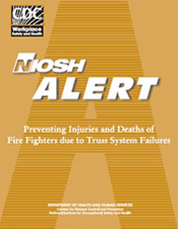
The following publication was designed to provide guidance for emergency response after large structural collapse events. The material covers different hazards that emergency response and recovery workers may face when entering in these type of structures, characterizes different hazards, provides recommendations on PPE ensembles and use, advices on the logistic procedures necessary to use and maintain structural collapsed edifications and prevent further damage, and addresses the training and equipment necessary to support recovery activities protecting the health and safety of emergency responders and recovery workers.
Personal Protective Equipment Guidelines for Structural Collapse Events, Rand Volume 4
En Español
This NIOSH publication covers the hazards associated to roof and floor truss collapses during fire-fighting operations. Given the structural and environmental conditions of a location on fire it is difficult to predict a structural collapse involving truss systems. This document describes the applicable standards to firefighting operations, building and construction codes and standards, and gives access to case reports involving firefighter fatalities. From previous experiences, this publication provides recommendations on operating procedures that should be followed to protect the health and safety of firefighters.
NIOSH Alert: Preventing Injuries and Deaths of Fire Fighters due to Truss System Failures
En Español
This NIOSH publication provides recommendations to fire departments to minimize the risk of injury and death among firefighters during structural firefighting operations. The document offers a background and Includes 10 essential steps to minimize the risk of injury and death, mentions the current applicable OSHA and NFPA standards, and documents case studies with applicable recommendations to minimize the risk of injury and death.
NIOSH Alert: Preventing Injuries and Deaths of Fire Fighters due to Structural Collapse
Collapsed structures are a high risk environments for emergency responders. The following page defines structural collapse and its associated hazards. The page includes safety and health recommendations to be used during a collapsed structure response, and describes the types of hazards emergency response and recovery workers may encounter when entering to a collapsed structure.
OSHA Structural Collapse Topic Page
